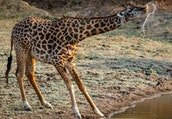- 1. Africa Impala Appearance Impalas have a sleek and slender body, with a reddish-brown coat on the back and sides and a lighter cream color on the belly. Males, known as rams, are larger than females, known as ewes. Both males and females have long, curved horns that grow vertically from the top of their heads.
- 2. Africa Impala Size: Adult impalas stand about 30 to 36 inches (75 to 90 centimeters) tall at the shoulder and can weigh between 88 to 165 pounds (40 to 75 kilograms).
- 3. Africa Impala Habitat: Impalas are highly adaptable and can be found in a variety of habitats, including savannas, grasslands, woodlands, and floodplains. They are particularly well-suited to areas with open spaces for grazing and nearby cover for protection.
- 4. Africa Impala Diet: Impalas are herbivores and primarily graze on grasses, leaves, and shoots. They are selective feeders, choosing young and nutritious plants for their diet.
- 5. Africa Impala Behavior: Impalas are social animals and are usually found in herds ranging from a few individuals to large groups of hundreds. These herds consist of females and their young, while males often form bachelor groups or are solitary outside of the breeding season.
- 6. Africa Impala Reproduction: Impalas breed seasonally, and the mating season is known as the rut. During the rut, male impalas engage in intense competition for access to females, displaying territorial behavior and fighting with other males.
- 7. Africa Impala Predation: Impalas are prey to various predators in Africa, including lions, leopards, cheetahs, wild dogs, and Impalas. They rely on their speed and agility to escape predators, and their herding behavior provides added protection against attacks.
- 8. Africa Impala Conservation Status: The impala is considered a species of "Least Concern" by the International Union for Conservation of Nature (IUCN) due to its wide distribution and stable population. However, localized threats such as habitat loss and poaching can impact specific populations.
Africa Impala:
The impala (Aepyceros melampus) is a medium-sized antelope species found throughout various regions of Africa. Impalas are graceful and agile animals that are often seen on safaris in various African countries. They are known for their impressive leaping ability, capable of jumping up to 10 feet (3 meters) in the air, which is called "pronking." Observing impalas in the wild is a common and delightful sight, adding to the beauty and diversity of the African savannas and grasslands.
Africa Safari Tour Book online The Impala safari
Here is some information about the impala:
Africa Impala Safari Tour
An Africa impala safari offers an incredible opportunity to observe these graceful antelopes in their natural habitat. Here are some key points to consider when planning an impala safari:
By planning ahead and choosing reputable safari operators or guides, you can have an unforgettable safari tour focused on observing impalas and experiencing the wonders of Africa's wildlife.
Africa Impala Safari Destinations
Safari Destinations: Impalas are widely distributed throughout many African countries, making them a common sight on safaris in various regions. Some popular safari destinations to observe impalas include:
- Tanzania: Serengeti National Park, Ngorongoro Crater, and Selous Game Reserve.
- Kenya: Maasai Mara National Reserve, Amboseli National Park.
- Botswana: Chobe National Park, Moremi Game Reserve.
- South Africa: Kruger National Park, Hluhluwe-iMfolozi Park.
- Namibia: Etosha National Park, Namib-Naukluft National Park.
Africa Impala Safari Game Drives
Participate in game drives, which are guided tours in open vehicles, to explore the national parks and reserves where impalas are commonly found. Game drives offer excellent opportunities for wildlife viewing, including impalas and other African wildlife.
Africa Impala Safari Night Drives
Night Drives: Some safari destinations offer night drives, which can be an excellent way to spot nocturnal animals such as Impalas. Impalas are more active at night and are often seen scavenging or hunting during the dark hours.
Africa Impala Safari Wildlife Diversity
Wildlife Diversity: While on your impala safari, you'll likely encounter a diverse range of African wildlife, including other antelope species, predators like lions and cheetahs, elephants, giraffes, and an abundance of birdlife.
Africa Impala Safari Guided Walking Safaris
Guided Walking Safaris: Consider participating in guided walking safaris to get up close to impalas and experience the African bush on foot. Walking safaris provide a more intimate and immersive experience with the wildlife and their natural environment.
Africa Impala Safari Accommodations
Accommodations: Choose accommodations located within or near the national parks and reserves, allowing for easy access to impala-rich areas. Many lodges and camps offer guided game drives and walking safaris as part of their safari packages.
Africa Impala Safari Photography Opportunities
Photography Opportunities: Bring a good camera with a zoom lens to capture impalas and other wildlife in their natural habitats. A pair of binoculars will also be useful for better wildlife viewing.
Africa Impala Conservation and Responsible Tourism
Conservation and Responsible Tourism: Practice responsible wildlife viewing by following park regulations and respecting the natural behavior of impalas and other animals. Support conservation efforts that aim to protect the habitats and populations of these beautiful antelopes.








 |
|  |
|  |
|  |
| 